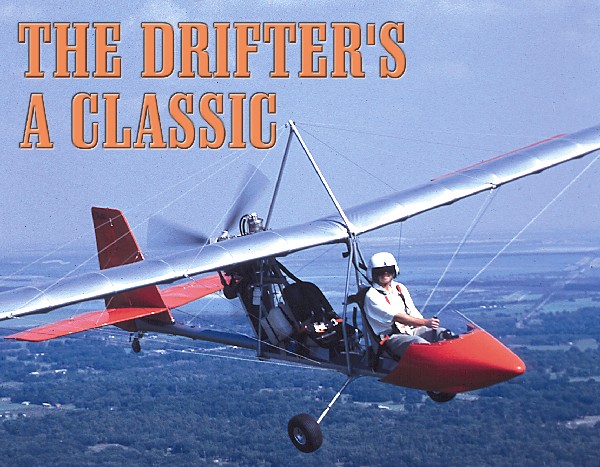
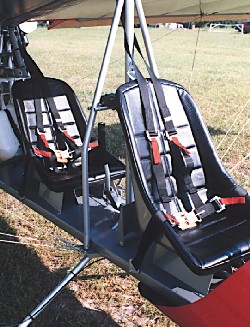
IMMEDIATE SEATING – The Drifter was one of the first tandem designs among ultralights (starting in ’83). Because the cabin is open, large pilots will feel at ease and the front seat offers visibility “as good as it gets.”
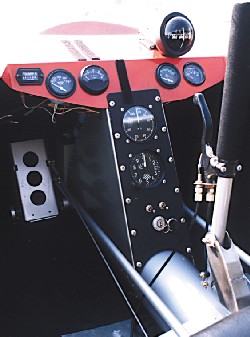
GAUGES APLENTY – With a small horizontal area and a extra T-shaped panel, the Drifter offers room for all the instrumentation you should need in this aircraft.

GAUGES APLENTY – With a small horizontal area and a extra T-shaped panel, the Drifter offers room for all the instrumentation you should need in this aircraft.

MAJOR POWERPLANT – Tagged the “Super Drifter” because of its powerful 81-hp Rotax 912 4-cycle engine, the aircraft is also available with a 65-hp Rotax 582, a 50-hp Rotax 503, or even a 40-hp Rotax 447 on the single-place version. A $25,000 price tag for the 912 may drive ultralight enthusiasts to the 2-stroke choices. The company is working on an HKS installation.
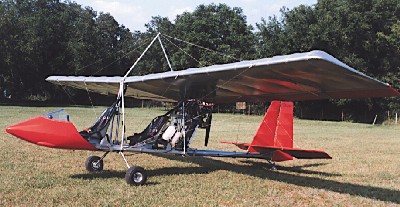
OFFICIAL COLORS – Owner/operator Tony Anderson had his Super Drifter decked out in the theme colors used by the famed Tuskegee Airmen aircraft as his tribute to these brave black pilots who served the U.S. in World War II.

FLOAT READY – This close-up view shows the float fittings already in place for this particular Super Drifter, which Ultralight Adventures! owner Tony Anderson will employ for his growing operation in the sunny city of Miami, Florida. Note the stainless steel bracket (near the base of the radiator).

NEW AND IMPROVED – The pod of the Drifter helped to coin the phrase pod-and-boom ultralight. It hasn’t changed much in all these years, and for good reason – it works very well. The front seat is quite sheltered, though the rear is much windier.
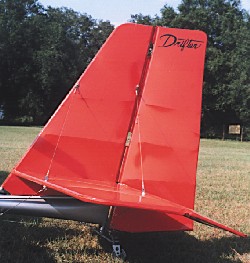
FAMOUS TAIL – First on the Drifter then enlarged for the Air Cam, the Drifter tail sets a benchmark for stable operations. It doesn’t hurt that the propblast is directly in front of these large surfaces.

YOUNG AND OLD – Miami-area flight school operator Tony Anderson poses with Lt. Col. Leo Gray, a member of the famous all-black Tuskegee Airmen who achieved fame for their courageous flying during World War II.
The original Drifter was one of the ultralight industry’s flagship aircraft. Hatched by early entrepreneur Dennis Franklin, the Maxair Drifter enjoyed immense popularity. Several reasons exist for the Drifter’s popularity, and these were enough for Leza-Lockwood to offer a rebirth to the design.
Déjà Vu All Over Again
The Drifter is a tough design. The basic airframe consists of a lower boom tube that supports the pilot at the front and the large empennage at the rear with an engine midship. Because the separation is longer than some similar designs, the Drifter boasts a high level of stability that should please most pilots.
Secured to the boom by a series of triangulated tubing structures, the wing is classic Klaus Hill. This prolific designer from the early ’80s died in an unfortunate accident many years ago, but not before putting his indelible mark all over ultralight aviation. Klaus is directly responsible for the wings of the Weedhopper, Hummer, Humbug and SuperFloater. These in turn spawned such aircraft as the Prospector and Vector. Especially as Hill’s wings appeared in the products of several companies, his name becomes legendary among ultralight designers.
Given the illustrious and successful history of the Drifter, perhaps it’s no surprise that Hill’s tubular ladder-style wing remains commonplace today.
The wing itself is a surprisingly rigid structure that employs sweep wires to assure the wing remains square with the fuselage. The network of tubing and wire bracing end up making the Drifter very strong and quite capable in more difficult weather conditions.
The Drifter in particular made good use of Klaus’ wing design. When combined with the robust lower “fuselage,” the design earned a well-deserved reputation for a workhorse machine. Thousands of early Drifters did duty as trainers, as bushplanes, as floatplanes, as banner tow machines, and still gave their owners great satisfaction for general fun flying.
The wonder is not that Sebring, Florida-based Leza-Lockwood chose to re-release the Drifter, but rather that it took so long.
Filling the Gap
Some years after Maxair suffered the loss of the design to a disreputable businessman, the Drifter went out of production. During this downtime, Drifter pilots were amazingly well-supported by Phil Lockwood.
Lockwood is known today for his Rotax engine and aircraft parts supply business (Lockwood Aviation Supply) as well as for his trailblazing twin-engine Air Cam design (produced by Leza-Lockwood). But long before these enterprises became icons of the ultralight industry, he was marketing director for Maxair and the Drifter of the day.
When Maxair left the business, Phil was savvy enough to distance himself from the questionable subsequent owner of the Drifter design. He started Lockwood Aviation Supply from scratch, and built it from a small engine specialist to a powerhouse of the ultralight industry. He achieved this by treating his customers well, knowing his products well, and maintaining a flair and style that are now his virtual trademarks.
During these years of developing business, Lockwood did his best to support hundreds of Drifter pilots around the world. He developed accessory items – like a flap kit – that were never offered with the original.
At least some Drifters continued to work hard thanks to Phil’s efforts. One notable example is a Drifter based in the popular tourist destination of Cancun, Mexico. Aerial ride provider and banner towing impresario, Luis Barocio, credits Lockwood with maintenance that allowed one ultralight among his fleet of Drifters to amass a stunning 10,000 hours of service!
Enter the Super Drifter
Partly because bannerman Barocio wanted a more powerful and more reliable machine and partly because Lockwood Aviation Supply was a Rotax supplier with considerable knowledge of the big engine, team members from Leza-Lockwood created the Super Drifter, powered by the 81-hp Rotax 912 4-stroke engine.
Says Leza-Lockwood marketing man John Hunter: “[The Super Drifter is] one of the lightest aircraft powered by the tried and true 81-hp Rotax 912.” This clearly gives it astonishing performance, but climb rates alone aren’t the total explanation.
For uses like Barocio’s, the Super Drifter may prove to be an excellent choice. The same can be said for Miami-based flight school operator Tony Anderson of Ultralight Adventures!. Both are quite obviously commercial operators who need consistency in their enterprises. You can’t run a business if your primary tool is down for maintenance.
The Super Drifter – pushed aloft by the big 912 – may be ideal for such operations. Besides a comfortable excess of power, it offers lower fuel burn than the Rotax 582, it is quieter, it goes longer between overhauls, and it may input less vibration to both airframe and pilot. That it drains the corporate checkbook by nearly $25,000 is a business expense justified by its added capabilities.
For “the rest of us,” as Apple® computer puts it, other choices of powerplant may be optimal.
First of all, the 65-hp Rotax 582-powered Drifter MU582 is a lot less expensive at $16,000 (before options). Or, if you can live with a 500-feet-per-minute climb at gross weight, the Drifter XP503 uses the very popular 50-hp Rotax 503 dual carb, which has proven to be plenty of power for a more lightly loaded Drifter. If you don’t need heavier options like electric starting, a 503 will fly the ultralight quite well, as demonstrated by many earlier machines so equipped. Best of all, the 2-seat Drifter XP503 model will save you considerably, dropping the price to a quite reasonable $13,990.
Thankfully, to my orientation anyway, Leza-Lockwood recognizes a single-place Drifter also has merit, and they offer one – the Drifter DR447 – with the 40-hp Rotax 447 2-stroke found on more and more Part 103 ultralights. With 40 horses, the single-seat Drifter performs very well (it used to do just fine with the 28-hp Rotax 277). The DR447 will set you back $12,985, a savings of only $1,000 over the 2-place XP503 version, but it can fit under Part 103 if you go lightly with the option list.
A single-place Drifter isn’t one of the cheapest choices you have among Part 103 ultralights, but you must understand the detail and precision that comes with airplanes rolling out of the Leza-Lockwood factory.
Mercedes of the Air
Phil Lockwood has always carried a sense of style and polish into his enterprises, and Leza-Lockwood benefits from his oversight. From the slick factory itself (you may not care to eat off the floor, but it looks clean enough to do so) to the high-end machinery used to make the little parts, the Sebring operation is a fine place to take a tour. It’ll reinforce your impression that ultralights are real aircraft, built by real engineers using real aviation techniques and hardware.
Last fall, Phil proudly showed me and BRS sales manager Gregg Ellsworth around the spanking new plant. In place after place, he was careful to point out the specifics of the building he designed himself. Everywhere we looked, it became obvious this wasn’t some converted garage, but rather a dedicated aircraft factory constructed from the ground up to make high-quality airplanes.
A few other factories compare well in one way or another, but none that I’ve seen can exceed the overall package at Leza-Lockwood.
Much credit needs to go to Phil and his carefully assembled staff of airplane builders, from Maxair founder Dennis Franklin (production manager) to marketing guru John Hunter. However, without the financial support of Antonio Leza, the place would look a lot different.
Some years ago, while immersed in the design of the Air Cam – a very big project in many ways – Lockwood encouraged Drifter enthusiast (but not then employee) John Hunter to help him find a financial partner. The twin-engine airplane project was draining Lockwood Aviation Supply and needed additional support. Hunter was a good choice, as he was then a financial planner with contacts among people with money. Hunter successfully linked up Lockwood with flying enthusiast Antonio Leza and the modern version of Lockwood’s enterprise was born.
Naturally, Leza-Lockwood is the manufacturer of the Air Cam kits that ship steadily from their impressive facility. They also build the kits for the Flightstar line under contract with Flightstar Sportplanes. Now a trio is formed with the Drifter series adding to that significant manufacturing capacity.
The return of the Drifter is cause for celebration in my mind.
Once and Still Excellent
The Drifter was always one of my favorites among ultralights. The design has earned an enviable reputation as not only tough and capable, but also delightful and confidence-inspiring. Leza-Lockwood is smart enough to leave well enough alone (mostly).
The Drifter is a pleasant-weather flying machine only, as it offers no enclosure. More than offsetting that shortcoming, in my mind, is the tremendous visibility offered. The front seat, perched out as it is on the extended lower boom, is arguably the best seat in ultralight aviation (exceeded only by the front seat on the Air Cam, an “ultralight” only in spirit).
What makes for a great seat also makes for very easy entry by all but a disabled pilot. Even the rear seat is easily reached, a fact not true on many tandem ships which ask you to twist and turn on seating yourself. Though the Drifter’s rear seat offers less visibility than the front, it is still superior to several other tandem aircraft (for example, Quicksilver’s GT 500).
The front seat puts you in charge of the Drifter, a realization that comes immediately as you prepare to taxi for takeoff. The seating position behind the substantial if low-profile nose pod and the solid feel of the rudder pedals assures you are in control.
An extended windscreen in the Drifter is not desirable as it may interfere with airflow over the center wing section. However, the big pod and small windscreen effectively block most of the airflow in this medium-speed ultralight. Nonetheless, I was happy to use a helmet with eye protection and recommend the same for any Drifter pilot.
You won’t worry about ground clearance as you taxi, because the Drifter sits fairly high on its spring steel landing gear legs. Two 5-gallon fuel tanks are standard, and their remaining supply can be viewed by pivoting and looking just aft of the rear seat.
As I refamiliarized myself with the Drifter’s cockpit, I judged little had been changed except for the addition of flaps since my last evaluation of the American-made Drifter 10 years ago. Flaps are deployed with a long lever hinging at the rear of the seat on the left side. Four detent positions, including zero flaps, make it easy to feel your way to the correct setting, and the long lever makes moving the flaps very easy. I chose to use none for takeoff, but varied the amount on landing approaches.
See the Whole World
General aviation pilots, or those used to full enclosures and more reference points, generally start off in the Drifter being quite unsure of their lateral movement. Not hard to understand, the Drifter wing is so far behind you it isn’t much help determining things like your bank angle. In addition, the lack of structure around you makes some pilots feel like they could fall out of the seat. The sturdy, positive-latching 4-point harness system should relieve the feeling.
Since I’m used to ultralights, and since I trusted the Drifter design, I immediately renewed my love affair with Drifter’s front seat. Positioning for takeoff at South Lakeland Airpark, I felt I could see the whole world around me. Such openness is highly valued when doing your pretakeoff traffic check.
In this Super Drifter model, the Rotax 912 engine gave a tremendous boost when you move the noise lever forward. This is surely not going to be common experience for those selecting the Drifter as their personal ultralight. If it were my money, I’d choose the immensely popular Rotax 503 as I’d probably fly the Drifter solo most of the time. When adding a student to the rear, you’d get less climb, but it’s plenty of power for most needs and more than ample for solo flight.
If you operate off of water – especially with amphibious gear – or if you regularly take two large people aloft, then the Rotax 582 option may be needed. It will add more than $2,000 to the price (though you’ll get a 3-blade versus 2-blade prop), but it also adds the need for a water temperature gauge and management of that resource. Choose the 582 if you must, but I prefer the greater simplicity and lower weight of the 503.
The Rotax 912 on this test airplane surely does make the Drifter super, but it also adds another $9,000 to the final price ($24,480). This may be an excellent choice for commercial operators, but is far out of the price range of most ultralight buyers.
Since I didn’t have to the buy the plane, though, I must admit I enjoyed the forceful acceleration of the 912 and its lower noise level once aloft. Fuel consumption may be as good as the 503 and is certainly better than the 582, so over the long haul, a 912 may fit your need and your pocketbook. But you have another choice coming that may be the best yet.
Leza-Lockwood will also offer the new 60-hp HKS 700E 4-stroke engine on the Drifter. This may be best of all, but it too will add dollars to your purchase price and weight to the airplane.
Adrift in the Sky
As soon as the Super Drifter became airborne, the familiar and comfortable Drifter flight qualities washed over me as did the warm spring breeze.
No one would call the Drifter “fast” in handling characteristics, but it is quite cooperative and obedient. Perhaps “authoritative” best describes the Drifter’s handling; it seems you always have enough. In crosswinds, the ultralight behaves very well.
The Super Drifter I flew had a rigging problem the factory has long since corrected. Apparently, the front seat had been moved aft to accommodate a taller pilot. When this happened, the rear seat pedals bumped into the front seat back.
“You were only getting about half the rudder travel expected,” stated John Hunter. However, you just read that I was satisfied with the handling (if not overwhelmed by roll rate). With the rudder working twice as hard, the handling power should increase, although I therefore wasn’t getting a true picture of the handling coordination.
With that 912 engine pushing you aloft, the Super Drifter is indeed super. Max climb at gross weight is listed at 1,000 fpm and I found it to be considerably stronger when flown solo, close to 1,300 fpm. That’ll get you out of virtually any sink situation.
The Super Drifter will also motor along at close to 70 according to the installed airspeed indicator. I’m sure the lower-powered 582 or 503 will run slower, although the HKS installation (under development at present) may maintain a more potent cruise given its particular strength in midrange power.
I’m fairly sure of the 70 mph high-cruise number because Hunter also told me the engine was somewhat underpitched. This 912 would only crank a bit over 5,000 rpm, which John said “produced about 80% of full power.” I never even noticed the shortfall while flying solo.
The Drifter was mild in every stall I performed. Even during steep banked accelerated stalls, the Drifter worked hard not to drop a wing, though the outside one usually would go if pushed severely enough. Power-on stalls never quit climbing. When tried aggressively, I got a thrill ride on the front of that Super Drifter standing on her tail while being pushed into the sky by 81 horses.
At trim power in cruise flight, the Drifter returns to level quickly when disturbed by a push or pull and release of the joystick. Comparable to my memory of the stable and secure GT 500, the Drifter quickly asserts its long tailfeathers to bring you back to a safe flight attitude. In training mode, this is a fine quality; old hands won’t mind it either.
With so much power on a high thrust line, the nose will push over under high power settings. This is common among pod-and-boom ultralights, and pitch is plenty authoritative to compensate. However, it isn’t the way certified airplanes work. You must properly handle 81 horses if you have them. Though I didn’t sample a 503- or HKS-powered Drifter, my bet is the nose-over tendency would be much less pronounced.
Get My Drift-Er?
Not everyone will run out and buy a Drifter. The design is old. It won’t enclose gracefully. It isn’t particularly fast. The wings don’t fold (though removal isn’t too bad).
Eliminating those buyers will only leave about half the ultralight community to be truly interested in Drifter qualities – plenty to sell hundreds more ultralights. Add the reliable aircraft to the Leza-Lockwood organization and the result is a good buy with good support and quality emphasized.
Leza-Lockwood is still spooling up Drifter production. After their first year or so, the company could – and still does – deliver a Flightstar kit out of stock. They’re packaged and ready for customers at almost all times.
Drifter delivery was quoted as 4 to 6 weeks as of June ’98. My bet is this timing will get shorter. On the other hand, I don’t see a way for that talented Lockwood team to make the Drifter itself any better.
Super or regular (engine, that is), the classic Drifter is back. Thank goodness!
| Seating | 2-seat, tandem |
| Empty weight | 495 pounds |
| Gross weight | 1,000 pounds |
| Wingspan | 30 feet |
| Wing area | 160 square feet |
| Wing loading | 6.3 pounds/sq ft |
| Length | 22 feet |
| Height | 10 feet |
| Kit type | Assembly |
| Build time | 160 hours |
| Set-up time | 30 minutes |
| Standard engine | Rotax 912 4-cycle |
| Power | 81 hp at 5,500 rpm |
| Power loading | 12.3 pounds/hp |
| Cruise speed | 75 mph at 4,800 rpm |
| Never exceed speed | 85 mph |
| Rate of climb at gross | 1,000 fpm |
| Takeoff distance at gross | 200 feet |
| Landing distance at gross | 200 feet |
| Standard Features | Dual controls, steerable tailwheel, nondifferential brakes, open cockpit with pilot pod and windscreen, kingpost-and-cable-braced wings and tail, spring steel landing gear, padded bucket seats, 4-point safety harnesses, 10 gallon fuel capacity, 3-blade composite prop. |
| Options | Flap/aileron kit, 5-gallon seat tank, ballistic emergency parachute, amphibious floats. |
| Construction | Aluminum tubing, spring steel landing gear, presewn Dacron® polyester sailcloth. |
Design
Cosmetic appearance, structural integrity, achievement of design goals, effectiveness of aerodynamics, ergonomics.
Pros – Classic design returns from the personnel who once staffed the original builder. This is not the heavier, wing-strutted Australian Drifter SB (see “Pilot’s Report – Back Up From Down Under, the New Drifter SB,” June ’97 UF!); it retains the lightweight features that made the first Drifters popular. Very well-executed (even to the Rotax 912 installation). Placement of prop above the “pan” protects blades against water spray or other debris. More than 1,000 original Drifters are flying.
Cons – For pilots used to enclosures, the massive visibility and lack of structure surrounding the pilot may be disconcerting. The 912-powered aircraft in this report is not a Part 103 ultralight, and you can feel the weight. Noncommercial operators should probably stick with the 503 or 582. Older design may not appeal to some buyers.
Systems
Subsystems available to pilot such as: Flaps; Fuel sources; Electric start; In-air restart; Brakes; Engine controls; Navigations; Radio; (items covered may be optional).
Pros – The original Drifters used full-span ailerons and no flaps. Now they’re available with a flap lever on the pilot’s left. Altimeter, ASI, tach, EGT and Hobbs are standard (plus water temp on the 582). You can have electric start (though not on the single-seat Part 103 version). An HKS model will be offered soon. Brakes are employed with a squeeze lever on the joystick. Very easy refueling access.
Cons – Rotax 912-equipped Drifter adds unnecessary complexity (not to mention weight and cost) for most ultralight enthusiasts. Brakes are unidirectional offering no taxi accommodation.
Cockpit/Cabin
Instrumentation; Ergonomics of controls; Creature comforts; (items covered may be optional).
Pros – Ask for only one distinguishing quality of the Drifter cabin and familiar pilots should exclaim, “the view!” Four-point harness system is standard. Very good entry and exit for both seats. Good support from padded fiberglass seats. Tiny little windscreen blocks front seat from most windblast. All instruments easily readable.
Cons – Test aircraft had the rear seat rudder pedals rigged too close to the seat for full deflection (caused when the front seat was moved aft to accommodate floats and a large pilot; problem has been remedied). Rear seat can be pretty windy. Seats do not adjust easily. Aft seat cannot see front seat instruments easily.
Ground Handling
Taxi visibility; Steering; Turn radius; Shock absorption; Stance/Stability; Braking.
Pros – Tailwheel steering brings responsive ground maneuvering. Visibility (from the front) doesn’t get any better; you can see the world from here. Spring steel gear legs offer good absorption even for the big 912 engine installation. Drifter’s gear has proven itself in some of the toughest duty situations imaginable. Clearance is good and the prop well-protected from debris strikes.
Cons – Lack of differential brakes offers no extra steering potential. As on most aircraft, the brakes aren’t particularly strong and are somewhat limited by your hand size and the ability to squeeze the lever. Aircraft is rather long; limited tight turning ability. Taildragger only; not all pilots feel comfortable with this gear setup.
Takeoff/Landing
Qualities; Efficiency; Ease; Comparative values.
Pros – Visibility from the front is absolutely superb; no excuse to miss anything in your path. Very rapid liftoff thanks to the 912 (but it is still quick even with a 503). Climb is awesome (1,000+ fpm) with the 912 and an adequate 500 fpm with the 503 even when two are aboard. Excellent crosswind capability. Good ground clearance. Flaps help steepen your approach.
Cons – The lack of visual bank and pitch references up front may be upsetting to some pilots used to lots of structure around them. Slips work but less effectively than an aircraft with covered fuselage. No other negatives.
Control
Quality and quantity for: Coordination; Authority; Pressures; Response; and Coupling.
Pros – Smooth, medium-light and powerful describes Drifter controls, yet it isn’t too fast for novice pilots. Makes a good trainer. Linkages are tight with little looseness and little friction. Dutch rolls to medium bank angles went well on first effort. Steep turns are a joy with good turning stall characteristics. Precision turns to headings were child’s play; any pilot should do well.
Cons – Due to the pilot’s position forward of the wing, you must use other references to determine bank angles; some pilots will not care for this. Test plane rudder required slightly more effort than joystick, a slight disharmony (but one that is quickly learned) – see article references on this. With full-span ailerons (no flap option selected), adverse yaw is significant.
Performance
Climb; Glide; Sink; Cruise/stall/max speeds; Endurance; Range; Maneuverability.
Pros – Fuel economy is improved with the 912 (over the 582, though less so for the 503). Climb is strong with 81-hp 912 or 65-hp 582, adequate with the 50-hp 503 – HKS option may be the ideal compromise. Design does very well on floats and has seen many forms of work duty around the world. Good slow or low flying, especially if optional flaps are selected.
Cons – Speeds are modest; this isn’t a long-range cross-country aircraft. Sink rate and glide are about average only (perhaps due to the lack of much enclosure). Rotax 582 model is quite a gas guzzler. While combination of performance is good, does not particularly shine in any one area.
Stability
Stall recovery and characteristics; Dampening; Spiral stability; Adverse yaw qualities.
Pros – Highly resistant to stall break; stays on heading and dips the nose only slightly whether power-on or -off. Pitch response to throttle movements is positive with little pitch change, perhaps as a big tail is close to the prop flow. Longitudinal stability is positive probably thanks to a longer wing to tail measurement.
Cons – Accelerated stalls at gross weight may fall toward a wing (though even this action is very mild). During power-on stalls, the nose gets very high with 912 engine. Nose-over on power increase is significant with 912; still exists with smaller powerplants.
Overall
Addresses the questions: “Will a buyer get what he/she expects to buy, and did the designer/builder achieve the chosen goal?”
Pros – Highly reliable pioneering design that still works very well in many applications. Use of presewn Dacron® wings greatly speeds construction and holds weight down (no weight-adding paint is needed). Cable-bracing remains one of the strongest ways to design an ultralight; it’s light and low drag. Drifter has been certified in Japan, South Africa, Taiwan and Israel. Company reputation is among the very best.
Cons – Removable but not folding wings. Prices start at $12,985 for a single-seater and run to nearly $25,000 for the Super Drifter with Rotax 912 4-stroke engine. Older design may limit interested buyers at resale time. No enclosure offered or possible without major work; cold weather locations may have shorter flying season. Factory still spooling up production (though this won’t take long).


Bonjour,
J’ai acheté un Maxair Drifter Monoplace en Italie, mais le problème :
– le vendeur ne sais pas exactement la date de construction.
– ni le numéro du serie .
Le problème s’impose pour la constitution du dossier pour avoir un numéro d’identification, sachant que la machine n’était pas immatriculé en Italie. Sauf une dizaine d’heures de vol, comment peut-on savoir le numéro du serie ?
[Computer translation]
I bought a Maxair Drifter Single-seater in Italy, but the problem: – the seller does not know the exact date of construction. – nor the serial number. The problem arises for the constitution of the file to obtain an identification number, knowing that the machine was not registered in Italy. Except for about ten hours of flight, how can we know the number of the series?
That aircraft is long out of manufacture. However, you may get some help from Lockwood Aircraft.
[computer translation]
Cet avion n’est plus fabriqué depuis longtemps. Cependant, vous pouvez obtenir de l’aide de Lockwood Aircraft.
Bonjour
Merci pour votre réponse 👍
I was part of the team that Denny Franklin put together that first thought of the Max Air rag wing super light in the 1980s, built as an easy to assemble kit on a long aluminum irrigation tube/pipe, to be sold for very little money. It was called MaxAir because Maxine was Denny’s girl friend at the time. I suggested the name. If any one would like to learn more about the origins, please get in touch with me. There is quite a story within it.
Hi David, What is going on with Denny, i was around him in his Sebring’s hanger for 6 months as he built my 912 Drifter on floats. It was back in 2006-7.